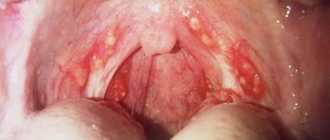Children, teenagers, and adult men and women are all at risk of suddenly experiencing an unpleasant sore throat when swallowing. The causes of this phenomenon can be mechanical injuries to the oral cavity and larynx, various viral infections, bacteria and even tumor growths. If unpleasant symptoms occur, it is best to immediately make an appointment with a specialist to identify the causes and eliminate them.
Physiology of sore throat
What is pain in the throat like? This is discomfort that appears when soft tissues are affected. It occurs when many nociceptors are stimulated, which are located on the mucous membranes. Unpleasant sensations can arise due to various (mechanical, temperature) factors, including the consumption of chemicals. The receptors are activated, and the nervous system reports: inflammation has appeared.
There are a huge number of causes of sore throat, but it is worth highlighting several main groups:
- Infectious and inflammatory diseases (ARVI, measles, rubella, chronic inflammation)
- Inflammation due to non-infectious factors (pharyngitis, injuries of the larynx and pharynx, burns, foreign bodies)
- Non-infectious pathology (Stylohyoid syndrome, galvanism, diseased kidneys, gastrointestinal diseases, etc.)
Accompanying diseases
Throat damage can occur due to diseases of various types. Pathologies accompanied by pain when swallowing:
- pharyngitis;
- ARVI;
- angina;
- measles;
- tuberculosis;
- trauma to the larynx or esophagus;
- gonorrhea of the pharynx;
- rubella;
- abscess of the retropharyngeal space;
- angina;
- candidiasis;
- mononucleosis;
- scarlet fever;
- diphtheria;
- chemical burn of the pharynx;
- acute thyroiditis;
- allergic reactions;
- radiation therapy;
- tumor of the thyroid gland or larynx;
- osteochondrosis;
- varicose veins of the esophagus.
The diagnosis is made based on objective examination data. Depending on the disease, treatment is prescribed.
Causes of sore throat
If we consider diseases as the cause of sore throat, the most common are pharyngitis and tonsillitis. At first, cough, conjunctivitis, and rhinitis are isolated. With tonsillitis, such an unpleasant phenomenon as an increase in temperature is noted. Common signs of diseases are considered to be
- inflammation of the tonsils
- inflammation of the pharynx
- general fatigue
Sometimes a sore throat can be caused by a bruise in the larynx. Such injuries lead to damage to cartilage tissue, the consequences are impaired breathing, internal bleeding, coughing, and in case of complications there is a risk of shock.
Oncology causes severe pain. If we consider cancer of the larynx or oral cavity, the causes may be abuse of tobacco products, alcohol, and also excessive environmental pollution.
In addition to the above causes of sore throat, there may be such anomalies as HIV, infectious mononucleosis, scarlet fever, allergies, reflux esophagitis. It is worth highlighting chronic fatigue syndrome and dry air. The last two can be avoided by correctly forming your daily routine and not allowing the air in the room where you are most of the day to become too dry, especially in winter.
Main reasons
- Sore throat and fever, weakness in the body - what could it be? What to drink for these symptoms
Most often, discomfort when swallowing is associated with the penetration of pathogenic viruses, bacteria, and fungi into the body. When infected with bacteria, pathological microorganisms release toxins, which cause cutting pain. Viruses can only reproduce inside cells and then kill them. This is the basis of pain during viral infection.
The cause of pain due to fungal infection is the germination of microflora through the skin, mucous membranes, bone tissue with rupture of intercellular connections. Swallowing saliva leads to mechanical irritation of damaged areas of the mucosa, which causes pain.
Symptoms of laryngitis
With this disease, the mucous layer of the larynx is affected. With a hidden flow, the right side of the throat begins to hurt, then an unpleasant feeling covers the left side. Negative sensations may have no connection with swallowing, but intensify when talking, breathing, or coughing.
Other signs of laryngitis include:
- general malaise;
- breathing problems;
- voice change;
- barking cough;
- heat.
Laryngitis often accompanies experienced smokers; it can occur when inhaling cold air with an open mouth in frosty weather.
Manifestations of tonsillitis (tonsillitis)
In this disease, inflammation affects the tonsils. They become covered with a white coating initially on one side, then it quickly moves to the other and looks like a cluster of white dots on red tonsils.
A sore throat begins with a sharp rise in temperature to 39°C and a rapid increase in inflammation in the throat. It becomes difficult for a person to swallow food, there is a decrease in appetite, and weakness.
When to see a doctor for a sore throat
Only an ENT doctor can make the most accurate diagnosis by studying the symptoms. Of course, in theory, you can listen to the pain yourself and make your own assumptions based on the description. But under no circumstances ignore the help of a specialist!
If there seems to be a lump in the throat and discomfort occurs when swallowing, pharyngitis is most likely. This inflammation occurs due to viruses or bacteria. There is also a high body temperature, muscle pain, and a severe cough. In a neglected state, pharyngitis can develop into a sore throat or bronchitis.
Unilateral sore throat
If you have a sore throat on only one side, it makes sense to talk about a locally affecting infection: damage to the lymph nodes, acute otitis media, infection with harmful streptococci, scarlet fever, diphtheria, measles, and the like.
Pain in the Adam's apple area
If the Adam's apple area hurts, then the mechanical injuries described above are most likely. This is most often the case among athletes and people leading an active lifestyle. With such damage, there is a possibility of fracture of the cartilaginous soft tissues. If you feel difficulty breathing, a crunch in the throat and blood when coughing, consult a doctor immediately!
Pain radiating to the ear
Pain radiating to the ear is not always associated with a disease of the larynx only. Inflammation of the ears is possible, in which purulent discharge from the auditory organs is observed. Symptoms of this disease also include poor appetite, high fever and general weakness in the body.
Stitching pain in throat
Stitching pain often appears as a result of various foreign objects entering the throat, such as poorly chewed food, natural cereal fibers and shells, and fish bones. Such painful sensations are dangerous due to severe coughing and possible suffocation due to blocked airways. It’s not without reason that from childhood we are taught to chew food thoroughly and slowly and not to talk while eating.
Infectious causes of unilateral pain
Pathogenic viruses and bacteria, entering the respiratory tract, pass through the lymphoid ring of the nasopharynx, which performs a protective function. The palatine and nasopharyngeal tonsils neutralize foreign microorganisms.
Important! However, with a decrease in immunity, the lymphoid tissue is not able to cope with infectious agents. This occurs more often in children and older people.
Provoking factors can weaken the body’s protective function:
- smoking, which interferes with the blood circulation of the mucous membranes;
- deficiency of vitamin B and ascorbic acid;
- foci of chronic infection of the oral cavity – dental caries;
- adenoid growths;
- working in hazardous industries where you inhale toxic fumes.
A sore throat on the left side can be caused by any of these risk factors. For example, an infection from a carious tooth first penetrates into the neighboring tonsil. In this case, a person has a sore throat on the left side, and it hurts to swallow food.
Treatment
Of course, the method of treatment and choice of medications is directly related to the identified diagnosis. That is why you should not engage in home research and self-medication, because only an otolaryngologist can make the correct diagnosis. Moreover, it will be very difficult to obtain antibiotics without a prescription, but even if it is possible to purchase such drugs without a prescription, there is a risk of causing great harm to your health instead of treatment, disrupting the body’s microflora. Do not forget about the compatibility of various drugs.
Never self-medicate children and pregnant women!
Traditional methods of treatment
If an immediate visit to the doctor is not possible, and the first symptoms of a sore throat appear, you can resort to “first aid”, which will allow you to irritate the sore spot less and make subsequent therapy more effective:
- Keep conversations to a minimum;
- Avoid drinking alcohol and cigarettes during illness;
- Stock up on lollipops and lozenges for sore throat and cough;
- Drink as much hot liquids as possible, such as tea with ginger and lemon.
- Gargle with special solutions from pharmacies.
If the sore throat becomes unbearable, you can take a painkiller.
Peritonsillar abscess
If your throat hurts on the left side when swallowing, doctors often detect acute inflammation of the soft tissues surrounding the tonsil. The so-called peritonsillar abscess, as a rule, develops with inadequate treatment, which is carried out by the patient at his own discretion.
But this also happens in patients with severely weakened immunity or resistance of pathogenic microflora to antibiotics.
As the abscess progresses, a large amount of pus accumulates in the tissue, which is accompanied by intoxication of the body. This means a temperature rise above 39.0 °C, an increasing sore throat, and a spasm of the masticatory muscles.
Important! The patient's condition becomes so dangerous that it can develop into sepsis or meningitis. A patient with a peritonsillar abscess needs emergency care from an ENT doctor in a hospital setting.
The patient undergoes surgical treatment - puncture and drainage of the cavity, followed by intravenous infusion of glucocorticoid drugs.
Medications
In pharmacies, for a sore throat, you can find and try the following types of medications:
- Antibacterial and anti-inflammatory drugs (hexoral, diclofenac);
- Rinse liquid (furacilin, chlorhexidine);
- Sprays with antibacterial and analgesic effects (oracept, bioparox, lidocaine);
- Tablets and lozenges (faringosept, strepsils, septolete, gramidin).
To enhance treatment with medications, you can add folk remedies as therapy. This will also help reduce the first unpleasant pain sensations. But even here it’s worth knowing when to stop.
- Rinsing the mouth and throat with solutions of soda, salt and iodine. In a glass of water, mix one teaspoon of salt and soda, add 4-5 drops of iodine. Another option for rinsing solution is diluted potassium permanganate.
- Steam baths and inhalations based on medicinal herbs. Proven plants include the well-known chamomile, oak bark, and calendula. It costs about 10 minutes to breathe beneficial vapors.
- Sweet folk remedy is a mixture of cinnamon, milk and honey. This spicy, healthy sweet is best offered to children. You should take about half a glass at one time.
Never delay treating your throat!
Complications from such a seemingly simple disease may well include bronchitis, otitis media, sinusitis, tonsillitis and pneumonia. Here sore ears, affected joints, heart pathologies and kidney failure are already added.
Treatment and prevention of symptoms of cervical osteochondrosis
Comprehensive treatment of the symptoms of cervical osteochondrosis includes drug therapy, exercise therapy, physiotherapy, massage and maintaining a healthy diet.
Please note that at the 1st, preclinical, stage, a complete cure for cervical osteochondrosis is possible! This requires a change in lifestyle to a more active one, daily therapeutic exercises, and a balanced diet.
In advanced cases, surgical treatment may be required (if a vertebra is displaced, a hernia forms, or a severe narrowing of the lumen of the spinal column).
Massage for cervical osteochondrosis
Massage of the cervical-collar area is an excellent way to prevent the development of cervical osteochondrosis and protect against its exacerbations. It helps relieve pain, strengthens muscles and improves tissue trophism (after a session, patients often “clear their heads”). Some massage techniques are only available to qualified professionals. They should not be repeated at home, since the neck contains a huge number of nerve bundles and blood vessels. Clamping them is fraught with loss of consciousness, the development of inflammation in the nerve endings, and disruption of brain trophism.
But a simple “household” massage with warming and pain-relieving ointments, creams and balms can be performed at home. It helps relax muscles and eliminate “tightness”
Remember that if there is inflammation (swelling, increased sensitivity of the skin, local increase in temperature), massage is strictly prohibited! It will only worsen the patient's condition! Also, “home” massage is contraindicated for hypertonicity of the muscles of the cervical-collar area. In this case, you should contact a specialist or start with special therapeutic exercises.
Classic massage techniques for symptoms of cervical osteochondrosis include:
- stroking the skin from the back of the head to the subclavian area to warm the skin and relax the muscles;
- squeezing - performed by a kind of “grab” between the thumb and index finger. In this case, it is necessary to clasp the neck, gently pressing on the muscles and stretching them;
- rubbing - affects the skin and muscles, warming them up, relaxes the so-called. “protective” tension, restores impaired blood circulation;
- kneading - affects the deep layers of tissue, so it must be performed strictly by a specialist.
Please note that massage techniques, intensity and localization of massage effects vary depending on the stage of cervical osteochondrosis. If the patient is bothered by pain on only one side, the massage is performed symmetrically, starting with the healthy half. Before a neck massage, it is advisable to warm up the entire back, since the position and nutrition of the vertebrae with osteochondrosis can be disrupted according to the domino principle.
Therapeutic exercises for cervical osteochondrosis
Therapeutic exercises for cervical osteochondrosis can be performed at home and at work. An important condition: the entire set of exercises should be done daily, ideally 3-4 times a day. If you spend a lot of time at the computer or in one position, every 1.5-2 hours you should take a 5-minute break to warm up.
Exercise therapy for cervical osteochondrosis helps strengthen the neck muscles, eliminate tension, and restore blood circulation.
- Sit straight on a chair. Without sudden movements, turn your head left and right, making a 180° turn.
- Lower your head down, trying to reach your chin to your chest, but without pulling your shoulders forward.
- Tuck your chin in, trying to bring it behind your chest line.
- Sit at the table and place your elbows on it. Place your palms on your temples and turn your head, overcoming moderate resistance from your own hands. Repeat for head tilts (with your palm on your forehead).
- Pull your shoulders toward your earlobes and then lower them.
- Do a self-massage of the back of your head.
For patients with cervical osteochondrosis, water activities are recommended: swimming, water aerobics, hydromassage and others.
In addition to therapeutic exercises, patients with symptoms of cervical osteochondrosis are advised to wear special orthoses-collars, which help reduce compression of nerve endings, serve as the prevention of hernias, and combat sore throat and trophic disorders.
Physiotherapy for symptoms of cervical osteochondrosis
Physiotherapy for symptoms of cervical osteochondrosis in women and men is carried out in courses several times a year. It allows you to slow down the progression of the disease and its complications, and relieve symptoms.
For pathology of the cervical spine it is recommended:
- magnetic therapy;
- laser therapy;
- shock wave therapy;
- mud therapy and balneotherapy;
- hydromassage;
- manual therapy;
- traction therapy;
- mechanotherapy.
Medicines for cervical osteochondrosis
To relieve symptoms of cervical osteochondrosis in women and men, the following groups of drugs are used:
- Non-steroidal anti-inflammatory drugs (Nimesil, Etoricoxib) - help relieve pain, inflammation and swelling, but are taken in symptomatic courses (about 10-12 days) and do not affect the causes of the disease.
- Glucocorticoids (Prednisolone, Diprospan) are indicated to eliminate pain and decompress nerve roots in severe cases when simple analgesics and NSAIDs are ineffective. They have significant side effects and should be used strictly as prescribed by your doctor.
- Blood microcirculation correctors, angioprotectors (Pentoxifylline, Actovegin) - help improve blood circulation and protect brain vessels from damage.
- Chondroprotectors (Artracam) - affect the very cause of the disease (deterioration in the quality of intervertebral discs). This group of drugs promotes the structural normalization of cartilage tissue, its rapid regeneration and normal nutrition. Of all the medications, only chondroprotectors are truly capable of slowing down the destruction of cartilage and improving their shock-absorbing qualities (all others only relieve symptoms).
Prevention
Throat diseases can be avoided if you follow simple rules of a healthy lifestyle. The list of useful actions includes hardening, proper balanced nutrition, walks in the fresh air, active recreation, sports, and giving up bad habits such as alcohol and smoking.
Any complex throat disease can be prevented in time and eliminated in the initial stages, following the advice and recommendations of the attending physician. Correct therapy guarantees the result in the form of absolute recovery. You should not delay treatment and make unclear diagnoses on your own; treatment of the throat, as well as other organs, should always be trusted to specialists.









